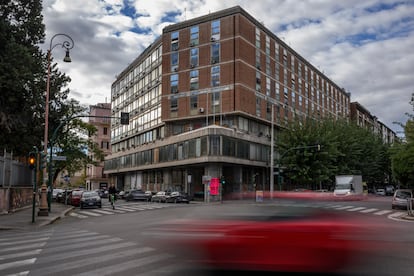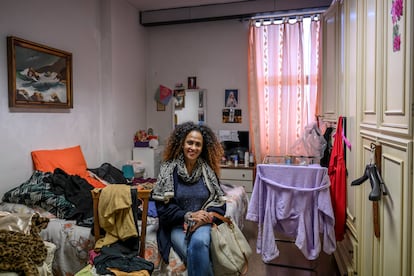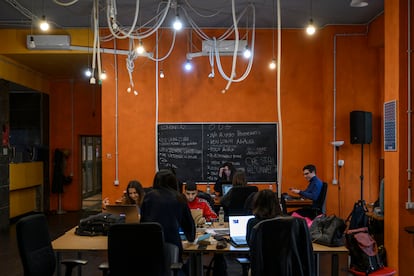The squat house that the Pope fell in love with bothers the Italian government
Prime Minister Meloni’s administration wants to evict Spin Time — the largest community center in the country — from its location. The organization shelters 450 vulnerable people and functions as a branch of Rome’s social services

One of the first decisions that the far-right Matteo Salvini made when he was appointed as Italy’s minister of the interior in 2019 was to cut the power at Spin Time: the largest social assistance center in Italy.
The building — home to 450 vulnerable people, located in the heart of Rome — uses electricity not only for lighting, but also to synchronize the pacemakers for some of the residents. After a week in the dark — on a Saturday afternoon, on May 11, 2019 — a guy who looked like a parish priest showed up at the center. In reality, he was a cardinal… and one of Pope Francis’ most-trusted people.
Before he joined the priesthood, Konrad Krajewski had been an electrician in his native Poland. He rolled up his sleeves, went down to the electrical room and turned the power back on. He also left his business card, in case Salvini — or whoever else needed explanations — tried to bother them again.
That day, Spin Time became a reference in the fight against intolerance. It established a direct channel with the Vatican and with the ope, who periodically receives some of its tenants and officials. “Look, this photo is from last week,” says Paolo Perrini, president of the association that manages the center, showing his phone to EL PAÍS. The pope appears with a group of residents of Spin Time, individuals of migrant origin.
The building — which was once the headquarters of the National Institute for Social Security — was occupied in 2013 by members of Action, a decent housing collective. Today, it houses 150 family units, with residents hailing from 27 different nationalities. The space — at just over 200,000 square feet — is one of the largest centers of its kind in Europe. There are seven floors above-ground and three floors beneath: there’s a restaurant, a cinema, a concert hall, a hairdresser, a recording studio and the most widely-distributed university newspaper in Europe, which churns out 200,000 print copies each month.
Once again, however, Salvini is a problem. Now the deputy prime minister to the far-right Giorgia Meloni, he made Matteo Piantedosi the minister of interior last year. His appointee has said that it’s “advisable” for Spin Time to vacate the building before Christmas.

The City Council of Rome — governed by the center-left Roberto Gualtieri — has assured the federal government that it will buy the property (the asking price is $43 million) and transfer it to the current administrators, so that they may continue their social work. But the negotiation is dragging on and the Ministry of the Interior continues to insist on the option of eviction. As a result — just like what happened when the cardinal got the power turned back on — the news of this threat has reached 130 countries.
With all the attention, the film director Ken Loach presented his latest film — The Old Oak — at the social assistance center on November 16. The British filmmaker wanted to show his support for Spin Time’s continuity. “The right uses immigration to divide us, they fear the strength of the workers,” he bellowed, before an audience that had been waiting for him for hours. Among those present were hundreds of migrants.
Spin Time is in the Roman neighborhood of Esquilino, one of the most culturally and ethnically diverse areas of the city. Two volunteers take turns at the entrance of the building, assisting the families who come to ask for asylum or advice. Once you pass the door — presided over by a piece of wood from the migrant boat that sank in Calabria this past February — you enter a collaborative universe, which functions like a well-oiled machine.
On the ground floor, there’s a coworking space, where some students are busy. There’s also a small legal aid office for migrants, as well as a room where vegetable merchants can ship their produce to clients throughout the neighborhood.

All seven above-ground stories of the building welcome migrants. The old offices that were once used by Social Security officials have been converted into small studios for resident families. The hallways smell of spices and aromas of dishes from various parts of the world: the food is cooked in the community kitchen. Those who have several children can occupy up to three rooms. For those who live alone — a minority — such as Lucia, who arrived from Eritrea more than a decade ago, the available space is somewhat smaller. “I arrived in Italy a long time ago. My children live on their own, but I’m fine here. I coexist well with all the activities they organize in the house,” she explains.
The activities she’s referring to include concerts, conferences and theater rehearsals. There’s a room used by several companies to prepare works that are performed in the most important theaters in the country, while the Clandestina Night Orchestra — which has 48 musicians and tours throughout Italy — also holds rehearsals in the space. There are also language courses and a carpentry workshop that produces everything needed to update the interior of the building, while also attending to external clients.
Daniele — the carpenter — shows EL PAÍS the space. He explains that, of all the income he generates, he gives 30% to the Spin Time organization as a contribution. The same practice is observed by the hairdresser, the restaurateur, the operator of the recording studio and the Scomodo newsroom.

The headquarters of this student newspaper was designed by acclaimed Italian architect Renzo Piano, in what was once the old office parking lot. Here, a monthly magazine is written, designed and edited, with collaborators throughout Europe. It’s part of the sentimental education of Italian students. This crown jewel of the building will also be lost if the Ministry of the Interior carries out its threat of eviction and the City Council of Rome doesn’t quickly reach an agreement regarding the ownership of the building.
Sign up for our weekly newsletter to get more English-language news coverage from EL PAÍS USA Edition
Tu suscripción se está usando en otro dispositivo
¿Quieres añadir otro usuario a tu suscripción?
Si continúas leyendo en este dispositivo, no se podrá leer en el otro.
FlechaTu suscripción se está usando en otro dispositivo y solo puedes acceder a EL PAÍS desde un dispositivo a la vez.
Si quieres compartir tu cuenta, cambia tu suscripción a la modalidad Premium, así podrás añadir otro usuario. Cada uno accederá con su propia cuenta de email, lo que os permitirá personalizar vuestra experiencia en EL PAÍS.
¿Tienes una suscripción de empresa? Accede aquí para contratar más cuentas.
En el caso de no saber quién está usando tu cuenta, te recomendamos cambiar tu contraseña aquí.
Si decides continuar compartiendo tu cuenta, este mensaje se mostrará en tu dispositivo y en el de la otra persona que está usando tu cuenta de forma indefinida, afectando a tu experiencia de lectura. Puedes consultar aquí los términos y condiciones de la suscripción digital.
More information
Archived In
Últimas noticias
Most viewed
- Sinaloa Cartel war is taking its toll on Los Chapitos
- Oona Chaplin: ‘I told James Cameron that I was living in a treehouse and starting a permaculture project with a friend’
- Reinhard Genzel, Nobel laureate in physics: ‘One-minute videos will never give you the truth’
- Why the price of coffee has skyrocketed: from Brazilian plantations to specialty coffee houses
- Silver prices are going crazy: This is what’s fueling the rally











































